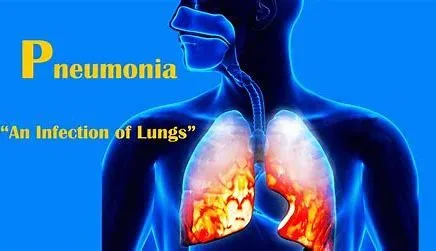Pneumonia represents a consequential infection characterized by inflammation affecting the air sacs within either or both the lungs. This malady may arise from bacterial, viral, or fungal origins. While pneumonia poses a grave health threat to individuals across various age groups, its impact is particularly perilous for elderly individuals.
Winter’s icy grip brings not just the magic of snow but also a heightened risk of pneumonia in elderly individuals. Let’s embark on a journey through the seasonal challenges of respiratory health.
The Frailty Factor
In the winter season, elderly individuals often grapple with frailty, making them more susceptible to respiratory infections. Pneumonia, an inflammatory lung condition, becomes a formidable foe in this delicate season.
The Winter Microcosm: A Breeding Ground
Picture the winter landscape as a microcosm where pneumonia-causing pathogens thrive. Cold air, indoor crowding, and weakened immune systems create an ideal environment for the microscopic invaders to flourish.
Weakened Immune System
The inclemency of cold weather has the propensity to compromise the immune system, rendering it more susceptible to infiltration by bacteria and viruses, consequently fostering the onset of infections within the body.
Ashok’s Tale: A Brush with Winter Pneumonia
Ashok is an 80-year-old retiree with a passion for winter walks. One frosty morning, he experienced the chill not just in the air but in his lungs as well. His battle with pneumonia serves as a poignant reminder of the risks lurking in the winter shadows.
Recognizing the Symptoms: A Call to Vigilance
Understanding pneumonia symptoms is akin to deciphering a winter code. Watch out for persistent cough, difficulty breathing, chest pain, and fever, as these signals may indicate a potential encounter with this seasonal respiratory adversary.
The Immune System’s Winter Battle
Delve into the intricacies of the immune system’s winter battle. Aging weakens the body’s defenses, making elderly individuals more susceptible to pneumonia. Vaccination becomes a shield, fortifying the immune response against specific pneumonia-causing agents.
Winter Wellness Warriors: Hydration and Nutrition
Empower elderly loved ones to be winter wellness warriors by staying well-hydrated and maintaining a nutritious diet. Adequate fluid intake and a balanced nutritional profile contribute to a robust immune system, ready to face winter’s respiratory challenges.
Indoor Air Quality: A Breath of Fresh Air
Transform the indoor environment into a sanctuary of clean air. Proper ventilation, humidifiers, and regular cleaning help as these measures reduce the concentration of airborne pathogens, mitigating the risk of pneumonia in enclosed spaces.
Doctor’s Orders: Timely Medical Intervention
In the winter pneumonia battleground, timely medical intervention serves as the frontline defense. Encourage regular check-ups, and at the first signs of respiratory distress, seek prompt medical attention to prevent the escalation of symptoms.
Vaccination: A Winter Armor
Vaccination emerges as a potent winter armor against pneumonia. Ensure that elderly individuals receive the pneumococcal vaccine, offering protection against a spectrum of bacteria responsible for respiratory infections.
Winter Hygge: Cozy, Safe, and Healthy
Embrace the Danish concept of “hygge” by creating a cozy, safe, and healthy winter haven for elderly family members. Warm blankets, well insulated homes, and the comforting presence of loved ones contribute to a holistic approach to well-being.
The Power of Respiratory Exercises
Unlock the power of respiratory exercises to enhance lung capacity and maintain respiratory health. Simple exercises, like yoga and meditation or the ones prescribed by healthcare professionals, can make a significant difference in reducing the vulnerability to winter pneumonia.
Community Support: Weaving a Safety Net
Envision a community safety net woven through awareness and support. Engage in dialogue with neighbors, friends, and local organizations to foster a collective effort in safeguarding the elderly population during the winter months.
The Role of Family: A Pillar of Strength
Family emerges as a pillar of strength in the face of winter pneumonia risks. Regular communication, active involvement in healthcare decisions, and emotional support form the bedrock of resilience for elderly individuals navigating the challenges of the season.
Here are few strategies for safeguarding lungs amid winter air pollution:
- Elevate indoor air quality by reducing chemical-cleaner usage, embracing natural ventilation strategies, and integrating the deployment of air purifiers for comprehensive filtration.
- Exercise prudence by abstaining from outdoor physical activities during episodes of heightened air pollution, thereby mitigating exposure to deleterious airborne contaminants.
- Foster pulmonary well-being by incorporating deep breathing exercises into daily routines, coupled with maintaining a nutritionally balanced diet and a disciplined routine of physical exercise.
- Wear protective masks when venturing outdoors amid suboptimal air quality conditions, effectively mitigating the inhalation of particulate matter detrimental to respiratory health.
- Maintain a hygienic domestic environment by meticulously eliminating dust, molds, and pet dander, fostering a clean haven that is conducive to respiratory health and free from potential airborne irritants.
- Maintain optimal lung health by decisively quitting smoking, recognizing its profound impact on respiratory function and overall well-being.
Conclusion: Navigating Winter’s Respiratory Landscape
The precipitous surge in pneumonia cases, propelled by the burgeoning levels of air pollution, underscores a disconcerting escalation in chronic health conditions. This acute increase in maladies of such gravity has, moreover, been correlated with the concurrent reduction in temperature. Recent reports have shown a threefold rise in the incidence of severe pulmonary disorders worldwide within the last few weeks. As the global panorama grapples with this burgeoning health crisis, discerning experts advocate heightened awareness and the implementation of judicious precautions to fortify and maintain optimal lung health. The imperative for vigilance and proactive measures resonates universally, emphasizing the urgent need for a collective commitment to mitigate the impact of this escalating public health challenge.
As we conclude this exploration of pneumonia in elderly people during winter, remember that knowledge and proactive measures are the keys to a resilient winter respiratory journey. Stay warm, stay informed, and cherish the winter tales of strength and survival.

